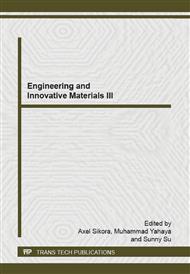p.57
p.65
p.71
p.76
p.81
p.85
p.91
p.96
p.101
Synthesis and Characterization of Octaethoxycalix[4]Arene for Heavy Metal Cations Adsorbent
Abstract:
Synthesis, characterization and evaluation of octaethoxycalix [4] arene as the heavy metal cations adsorbent has been carried out. The synthesis of the target molecule was conducted in five steps. The first step was synthesis of 2,4-diethoxy benzaldehide via Riemer-Tieman reaction of resorcinol and chloroform, followed by o-ethylaton, reduction using NaBH4 and ciclytation using AlCl3 catalyst. The characterization was performed by IR, 1H-NMR, 13C-NMR and Mass spectrometry. In this research the study of adsorption was also investigated. The product was obtained as white solid, melting point at 205oC-207oC with 69.74% yield. The adsorption result showed that optimum pH of the Cr3+ was 7 and the optimum pH of the Pb2+ and Cd2+ were 5. The percentage of Pb2+ and Cd2+cations which removed by octaethoxycalix [4] arene were 55.556% and 89.895% respectively. When the pH was 7, adsorption Cr3+ almost 100%. Equilibrium adsorption data of octaethoxycalix [4] arene was carried out at 298 K. Two isotherm models (Freundlich and Langmuir) were tested for modeling the adsorption isotherms. The Langmuir isoterm model showed more applicable than Freundlich. The Adsorption of octaethoxycalix [4] arene was determined on acidity where optimum adsorption happened in bonderline acidity level. The study of kinetic adsorption showed that octaetoxycalix [4] arene followed the kinetic model of Ho. The adsorption capacity (μmol/g) and adsorption energy (kJ/mol) octaetoxycalix [4] arene adsorbent in adsorption of Cr (III), Pb (II) and Cd (II) were (211.30: 26.46), (12.07: 26.64) and (67.730:26.46).
Info:
Periodical:
Pages:
81-84
Citation:
Online since:
October 2014
Keywords:
Price:
Сopyright:
© 2014 Trans Tech Publications Ltd. All Rights Reserved
Share:
Citation:


